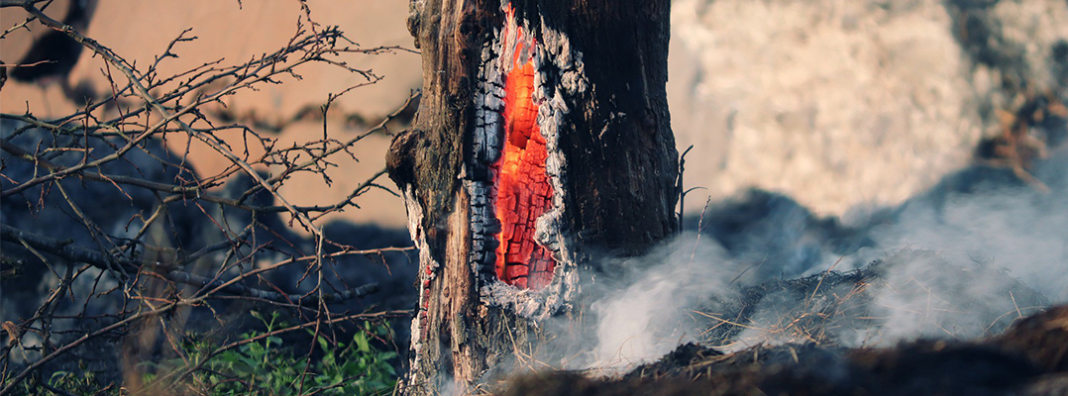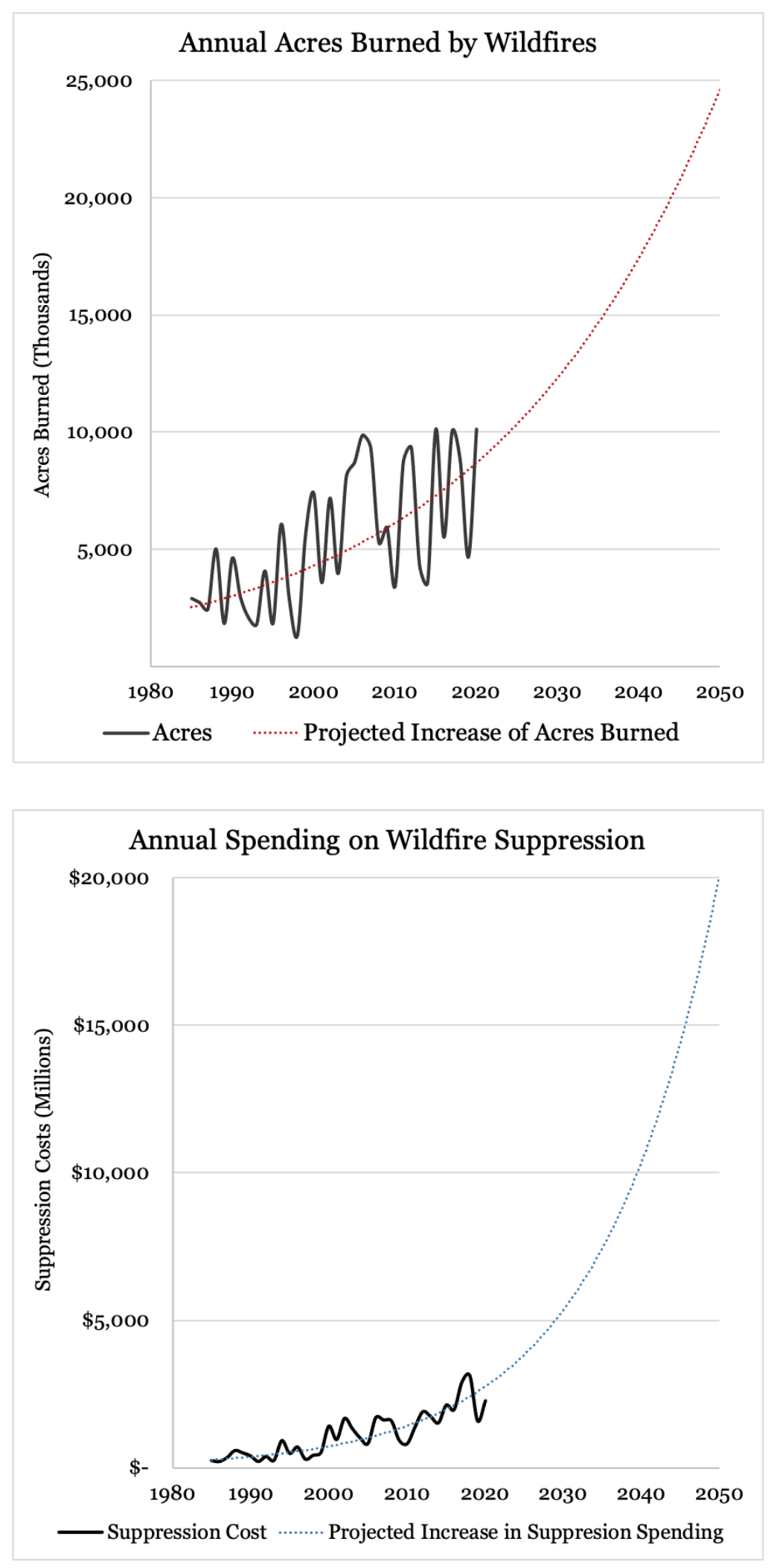
While a global pandemic may have overshadowed them, wildfires across the U.S. reached record levels in 2020. Nationally, 47,000+ fires burned over eight million acres, creating the third-largest burn area in the last decade. Both California and Colorado saw the single largest wildfires in state history. In California, lightning strikes sparked the August Complex Fire that burned over a million acres across six counties, earning it the grim designation of gigafire. Lightning caused hundreds of other fires across Northern California, including 367 during one storm alone last August. In Colorado, 2020 swept the podium for the largest fire season in state history.
Colorado’s largest fire last year, the Cameron Peak Fire, burned so many acres that it would qualify as Colorado’s fifth-worst fire season all on its own. The East Troublesome Fire, which was nearly as big as the Cameron Peak Fire, burned 120,000 acres in one day — that’s almost the size of Colorado Springs. Fires across the West caused 43 deaths and $16.5 billion in total damage. They also exposed millions to increased health risks due to dense concentrations of wildfire smoke in populated regions.
Record-breaking wildfire seasons like that of 2020 have become all too familiar. Fires due to natural and man-made causes have become larger and more destructive as a warming climate exacerbates fire conditions. Further, neglect of forests and lack of fuel management have turned many fire-prone landscapes into tinderboxes.
President Biden has cited growing wildfire concerns as part of his motivation for battling climate change. His administration’s ambitious plan is to set the US on a path to economic carbon neutrality by 2050. In the meantime, however, wildfires will likely continue to worsen. If they continue to grow at current rates, the graphs below show just how bad — and how expensive — fires might become before we even manage to reach carbon neutrality.
With decades more of fires headed our way, we have an opportunity to curb their impact immediately by improving the health of our forests. A similar focus on aggressive ecosystem-level action could prevent deaths and millions of dollars of property damage over a much shorter time scale. While eliminating emissions will reduce wildfire severity down the road, there are millions of Americans who are at risk of losing everything they own to wildfires in just a few short months. They don’t have decades to wait for improvements.
Source: National Interagency Fire Center
The Long Term Effects of Climate Change
Climate change has played a role in increasing the severity of wildfires and will continue to do so as we work to reduce carbon emissions. Fires burned late into the year as the West had its hottest August through October on record, and in Colorado, precipitation over the month of September was less than 10% of what the state would typically get. Increasing drought, heat, and aridity are priming the West for hotter and more hellish wildfire seasons as our climate continues to warm.
A warming climate also means more prolonged and strenuous wildfire seasons. Under a model with global CO2 emissions peaking around 2050, California is projected to see a 50% increase in the number of days with high or extreme fire risk. The USDA also estimates that the wildfire season is now 78 days longer than it was in the 1970s. Further, a 2016 study found that increased temperatures are to blame for over half of the observed increases in fuel aridity in US forests since 1978. The same study concludes that the combination of these conditions is responsible for 4.2 million hectares of forest fire area since 1984.
Fighting climate change and, by extension, reducing these wildfire-magnifying conditions will require significant investment and ingenuity across the next few decades. Even if the world is able to achieve net-zero carbon emissions by 2050 — which experts claim is necessary to avoid the worst effects of climate change — that leaves decades for wildfire conditions to continue to worsen. So, it’s equally essential that our federal, state, and local policymakers focus on the genuine short-term challenges facing communities exposed to wildfire risk.
What Can Be Done Now?
There are multiple ways that states can fight wildfires more effectively. One of these avenues is fuel reduction through prescribed (also called controlled) burning.
The National Cohesive Wildland Fire Management Strategy is a multi-agency review of the ways wildfire can be mitigated and fought. It identified prescribed burning as the most cost-effective forest management technique over the largest potential area of land. That last bit matters, as California, will need to treat roughly 20 million acres — or two-thirds of the state’s forests — to effectively mitigate fire at scale. Prescribed burning can be done on individual stacks of vegetation or across large tracts of land using broadcast burning. That makes it more cost-effective than fuel reduction through trimming and thinning, which would require investing in lumber mills and 3rd party contractors.
In 2019, southern states burned 5 million acres using controlled fires, and they’ve accounted for over 70% of total acres treated since 2010. Although western states have some natural disadvantages like drier climates and less accessible terrain, the asymmetric adoption of controlled burns may also come from a fundamental misalignment of incentives.
Wildfires vs. Prescribed Burns
Source: Climate Central
Carrying out these burns requires labor and investment from state and federal agencies who are facing a daunting catch-22 when it comes to allocating their budgets — spend now on fire prevention or save those funds to maximize the available budget for suppression efforts. According to Sonny Purdue, who served as the US Secretary of Agriculture under the previous administration,
“Forest Service spending on fire suppression in recent years has gone from 15 percent of the budget to 55 percent — or maybe even more — which means we have to keep borrowing from funds that are intended for forest management. We end up having to hoard all of the money that is intended for fire prevention, because we’re afraid we’re going to need it to actually fight fires. It means we can’t do the prescribed burning, harvesting, or insect control to prevent leaving a fuel load in the forest for future fires to feed on.”
A 2018 study also found that the largest barrier to more controlled burning by federal agencies was a lack of funding and labor capacity. With these hurdles in mind, it’s important to look at how we can design better policies to spur state and federal cooperation and create the right environment for action to happen in the short term.
Managing Risk and Enabling Cooperation
One of the key components to an effective, widespread fire response is well-aligned incentives. Federal, state, and private landowners and forest managers are responsible for the potential damages, air quality concerns, and overall risk when conducting prescribed burnings. In contrast, land managers are rarely, if ever, held liable for damages due to wildfires — which also produce much higher levels of pollution than controlled burns — no matter how poorly the land is managed. Ultimately, this means that agencies face an incentive not to engage in prescribed burning. By removing or reforming the barriers that these key decision-makers face, agencies will face better incentives to undertake prescribed burning and treatment projects that are key to reducing wildfire impacts.
Air quality concerns associated with burns can also stifle progress in forest management. In the West, smoke from prescribed burning has a markedly more negative public perception than in the South, where burns occur more routinely. Consequently, agencies have to be more sensitive to air quality concerns and face higher potential backlash when using controlled fires. However, relaxing air quality regulation around fire smoke would open the door for prescribed burning to become more commonplace around our communities. For example, up until 2019, Oregon had a zero-tolerance policy regarding air pollution from prescribed burns, meaning if any smoke from a burn enters a community, the burn is shut down. Not only did this make it harder to conduct prescribed burns near populated areas where it is most useful, but it also severely limited the value of prescribed burning. According to Ed Keith, the county forester for Deschutes County,
“Part of the consideration [for prescribed burning] is it takes just about the same amount of resources to do a 120-acre unit as it does to do a 500-acre unit as far as costs go.”
When Oregon changed the zero-tolerance rule in 2019 to allow a moderate level of smoke intrusion into communities (but at a level still below federal standards), the number of unacceptable smoke intrusions from prescribed burns fell, and total acres treated increased.
Another way that policy can reduce adverse pressure on land managers is by better enabling coordination with air-quality stakeholders. The Montana-Idaho Airshed group, for example, is a dedicated liaison between the states’ fire management agency and their Department of Environmental Quality. The increased communication between these groups helps mitigate the smoke impacts of fire control activities and educates the public about their value. Over time, steps like these will lower the barriers that land managers face to expand prescribed burning. While this expansion will come at the cost of some negative effects on air quality, the ability to have more control over smoke emissions and the reduced risk of larger wildfire events are key to reducing overall smoke exposure from wildfires.
A 2019 study combining input from land managers at the state and federal levels and air quality regulators characterized air quality risks as a scapegoat for a fundamental lack of inter-agency communication and participation rather than the primary barrier to more prescribed burning. What really would move the needle, they say, are policy changes that will allow state fire managers to work more closely with other state and federal agencies. Given that the federal government is responsible for 57% of California’s forests, versus 3% managed by the state, each should have a collaborative role in putting these changes into place. Better communication could occur in many ways, but “master agreements” between agencies to share employees, tools, etc., is one that land managers have found helpful. California and the U.S. Forest Service took a promising step last year by signing a Memorandum of Understanding to create a 20-year plan. The nonbinding agreement specifically laid out the goal to treat 1 million acres of forest annually, including prescribed fire and timber harvesting, by 2025.
The Biden administration has a promising opportunity to build on this cooperation through policy reforms that address the fundamental roadblocks to proactively reducing wildfire risks. While future generations stand to benefit greatly from present-day efforts to reduce carbon emissions, the growing wildfire risks facing present-day communities should not be neglected. Undertaking reforms focused on short-term solutions will not only help those currently at risk but will create healthier, more resilient forests for years to come.


